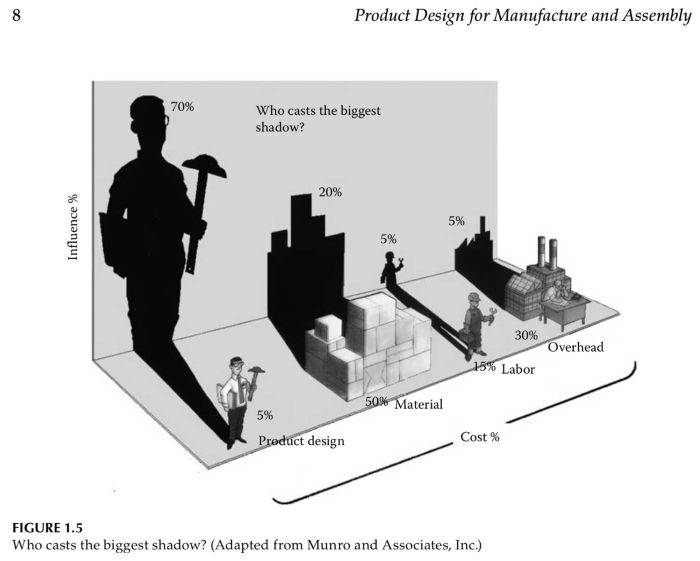
You are developing a new product or buying a product that is being produced for you. Naturally, the manufacturing costs of each unit made have a direct impact on your finances. They are quite important.
In simple terms:
The cost of the bill of materials + the cost of [assembly + testing + packing + inspecting] = the manufacturing costs.
However, what I will show in this article is, you need to keep other considerations in mind, too. This is especially important if you are designing or developing a new product.
As well as manufacturing costs, would-be product developers should consider the following…
We already know that manufacturing costs include the costs of materials, assembly, testing, packing, and more, but controlling these alone aren’t the key to getting your product into mass production and a successful product launch. You should also consider the following:1. You need stable manufacturing processes, obviously
Typically, the R&D team estimates the assembly, testing, and packing time when they do the ‘engineering build’. And that’s the basis of the quotation for the unit cost.
That estimate assumes that manufacturing will go relatively smoothly.
Now, what if manufacturing processes are not stable? They become a source of high extra costs, such as:
- A lot of extra inspection work is needed
- A lot of parts and/or products need to be reworked or scrapped. (Note: these losses are estimated in the unit manufacturing cost, but not at a high level).
- There is a lot more pressure, and it absorbs much more management time. A component supplier needs to be pushed hard to re-make a batch, the planning needs to be changed again and again…
- Some shipments may have to be expedited.
- In the worst case, a lot of defective products are shipped out.
And, in the end, who pays for all this? Even if a supplier absorbs some of these costs in the short term, the customer always ends up paying for it in the long run.
2. Most of the costs of the finished product are already set at the product design stage
Some studies have shown that, even though product design only represents a tiny share of expenses, it determines about 70% of the total costs of making a product. Here is a nice way of representing it:

Source: Product Design for Manufacture and Assembly
How can that be??
We can’t share any examples from our current and past projects (for confidentiality reasons), but there have been plenty of well-documented mistakes at the design stage that had a very large impact on the cost of manufacturing the product.
Juicero was one such of these products with an excessively complex design.

They raised 120 million USD in venture capital. They custom-designed many internal parts, where they could have used standard off-the-shelf parts. The machines had to be sold 400 USD a piece (excluding tax)… to squeeze fruit juice!
There are many ways a design can lead to lower costs: fewer parts, much easier assembly, cheaper materials, lower likelihood of running into certain quality issues, sticking to easy-to-get-right processes… And a good designer who is familiar with the realities of production will go in that direction.
Collaborative design reviews are usually needed, and getting to an easy-to-make design can take a lot of work!
3. Bad product design makes it IMPOSSIBLE to get into production at all
Kickstarter has provided many examples of very nice-looking products that, despite millions in funding, were unable to be manufactured.
One of those is the “Coolest Cooler”, with 13 million USD raised.

It had many features and it delighted would-be customers, but the difficulties to get it made in a high enough volume were unsurmountable, it seems.
One reason, in some cases, is the faith in the development of a never-done-before manufacturing process. Remember the project of using synthetic sapphire crystals on the iPhone? The manufacturer built a new factory, but couldn’t get enough output at a high quality.
This article shows examples of recurring quality issues. They basically got stuck in ever-running pilot runs.
We all need to learn from that and use high “manufacturing readiness” processes only. Even with Apple’s volumes and financial aid, this didn’t work.
*******
Conclusion
I hope it is now clear that product design is much more than “making it look nice”. It is important to spend time confirming that certain standard off-the-shelf parts are available on the market, that the product can be made using common manufacturing processes and common materials, and that the route to get into mass production is clear.
Are you planning to launch a new product soon?
About Renaud Anjoran
Renaud is a recognised expert in quality, reliability, and supply chain issues and is Agilian's Executive VP. He has decades of experience in electronics, textiles, plastic injection, die casting, eyewear, furniture, oil & gas, and paint. He is also an ASQ-Certified ‘Quality Engineer’, ‘Reliability Engineer’, and ‘Quality Manager’, and a certified ISO 9001, 13485, and 14001 Lead Auditor.



